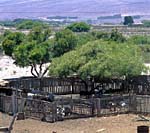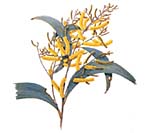|
|
|
Acacias have been used for sand stabilisation, Imperata grass control, mine site rehabilitation and to improve soil through the fixation of atmospheric nitrogen. Environmental advantages and production gains have been documented for mixed plantings of eucalypts and acacias in tropical and temperate regions (Khanna, 1999). The contribution to soil nitrogen cycling by acacias has a substantial impact on the early growth of eucalypts. In Vietnam, mixed plantings of eucalypts and acacias were also considered important for the maintenance of long-term site productivity (Nghia, 2000). A number of species such as A. ampliceps (Salt Wattle), A. salicina (Cooba), A. saligna (Coojong) and A. stenophylla (Eumong) have shown promise for soil stabilisation and dryland salinity control (Marcar et al., 1995). Acacia saligna has considerable potential in this role. In south-western Australia, for example, A. saligna is used to mitigate dryland salinity and has been successfully established by direct sowing in regions with an annual rainfall of 350-500 mm (Scheltema, 1992). In other parts of Australia, A. saligna has been used for rehabilitation of coal and mineral sand mine sites (Langkamp, 1987). Overseas, in North Africa, the Middle East and South America, A. saligna is also widely cultivated for agroforestry, wasteland rehabilitation and soil conservation purposes (El-Lakany, 1987; Crompton, 1992). Other species such as A. difficilis (River Wattle), A. tumida (Pindan Wattle) and A. torulosa (Torulosa Wattle) have been successfully used as windbreaks in the Sahel, West Africa (Thomson, 1992) and to stabilise large areas of barren wind-blown sands in dry parts of south-eastern Vietnam (Harwood et al., 1998). Acacia auriculiformis (Northern Black Wattle) has been widely used in India, Indonesia and Vietnam for land rehabilitation, particularly Imperata grasslands (Doran et al., 1997). Its success in this role is due to its spreading, densely-matted root system and its tolerance of infertile, acid, alkaline, saline or seasonally waterlogged sites.
Many acacias have been used or recommended for land rehabilitation and amenity plantings; for further information see Hall et al. (1972), Simpfendorfer (1975), Simmons (1988), Wrigley & Fagg (1988), Boland (1989), Lefroy et al. (1991), Whibley & Symon (1992), Lithgow (1997) and Doran & Turnbull (1997), Lithgow (1997) and Doran & Turnbull (1997); see also the AcaciaSearch project.
References
Boland, D.J. (ed.) (1989), Trees for the Tropics. Growing Australian Multipurpose Trees and Shrubs in Developing Countries. ACIAR Monograph No. 10. Australian Centre for International Agricultural Research, Canberra.
Crompton, H. (1992), Acacia saligna - for dryland fodder and soil stabilization, NFT Highlights, No. 92-03. Nitrogen Fixing Tree Association, Waimanalo, Hawaii.
Doran, J.C. & Turnbull, J.W. (1997), Australian Trees and Shrubs: Species for Land Rehabilitation and Farm Planting in the Tropics. ACIAR Monograph No. 24. Australian Centre for International Agricultural Research, Canberra.
Doran J.C., Turnbull, J.W., Martensz, P.N., Thomson, L.A.J. & Hall, N. (1997). Acacia auriculiformis, in J.C.Doran & J.W.Turnbull (eds), Australian Trees and Shrubs: Species for Land Rehabilitation and Farm Planting in the Tropics, pp.112-115. ACIAR Monograph No. 24. Australian Centre for International Agricultural Research, Canberra.
El-Lakany, M.H. (1987), Use of Australian acacias in North Africa, in J.W.Turnbull (ed.), Australian Acacias in Developing Countries. ACIAR Proceedings No.16, pp. 118-125. Australian Centre for International Agricultural Research, Canberra.
Hall, N.H., Boden, R.W., Christian, C.S., Condon, R.W., Dale, F.A., Hart, A.J., Leigh, J.H., Marshall, J.K., McArthur, A.G., Russell, V. & Turnbull, J.W. (1972), The Use of Trees and Shrubs in the Dry Country of Australia. Australian Government Publishing Service, Canberra.
Harwood, C.E., Kha, L.D., Dien, P.Q. & Thang, L.V. (1998), Performance of Australian dry-zone Acacia species on white sandy soils in south-eastern Vietnam, in J.W.Turnbull, H.R.Crompton & K.Pinyopusarerk (eds), Recent Developments in Acacia Planting. Proceedings of an international workshop held in Hanoi, Vietnam, 27-30 October, 1997. ACIAR Proceedings No. 82, pp. 29-35. Australian Centre for International Agricultural Research, Canberra.
Khanna, P.K. (1999), Gains from planting eucalypts and acacias, Onwood: research updates from CSIRO Forestry and Forest Products. Summer No. 23. CSIRO Forestry and Forest Products, Canberra.
Langkamp, P.J. (1987), Germination of Australian Native Plant Seed. Inkata Press, Melbourne.
Lefroy, E.C., Hobbs, R.J. & Atkins, L J. (1991), Revegetation Guide to the Central Wheatbelt. Bulletin No. 4231. Western Australian Department of Agriculture, Perth.
Lithgow, M.G. (1997), 60 wattles of the Chinchilla and Murilla Shires. Private publication. Chinchilla, Queensland.
Marcar, N.E., Crawford, D.F., Leppert, P., Jovanovic, T., Floyd, R. & Farrow, R. (1995), Trees for Saltland: a Guide to Selecting Species for Australia. CSIRO Division of Forestry, Canberra.
Maslin, B.R. (1998). Wattles of the Kalannie region: their identification, characteristics and utilisation. (CD ROM Publication for the Kalannie Land Care District by Dept. Conservation and Land Management, Perth.)
Nghia, N.H. (2000), Successful Development of Acacia Species in Vietnam. APAFRI Publication Series No. 5. Asia Pacific Association of Forestry Research Institutions, Kuala Lumpur.
Scheltema, M. (1992), Direct Seeding of Trees and Shrubs. Greening Western Australia, Perth.
Simmons, M.H. (1988), Acacias of Australia. Volume 2. Viking O'Neil, Melbourne.
Simpfendorfer, K.J. (1975), An Introduction to Trees for South-eastern Australia. Inkata, Melbourne.
Thomson, L.A.J. (1992), Australia's subtropical dry-zone Acacia species with human food potential, in A.P.N.House & C.E.Harwood (eds), Australian Dry-zone Acacias for Human Food. Proceedings of a workshop held at Glen Helen, Northern Territory, Australia, 7-10 August 1991, pp. 74-81. CSIRO Division of Forestry, Canberra.
Whibley, D.J.E. & Symon, D.E. (1992), Acacias of South Australia. The Flora and Fauna of South Australia Handbooks Committee. South Australian Government Printer, Adelaide.
Wrigley, J.W. & Fagg, M. (1988), Australian Native Plants: Propagation, Cultivation and Use in Landscaping. 3rd Edition. Angus and Robertson, Sydney.

